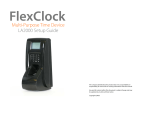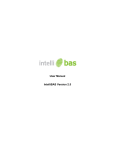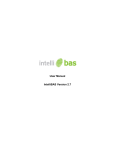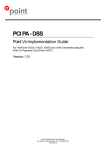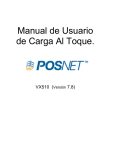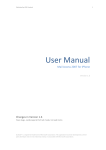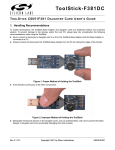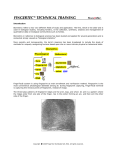Download FlexClock
Transcript
FlexClock Multi-Purpose Time Device Z-Series Setup Guide Z 23 Z 24 SETUP To set up your new FlexClock, there are only two cables to connect. One is for the power, and the other is an Ethernet cable that connects to your network. Connect the cables to the bottom of the clock. Your FlexClock Z-Series may have a third port (USB or serial). You do not need to connect anything to this. Once connected, the clock can be used immediately if the clock has already been added to your account. You may wish to hang your new FlexClock on a wall. Your FlexClock includes basic mounting hardware. To mount the Z23, use the hardware included to hang the clock directly on the screws. To mount the Z24, first mount the included backplate to the wall, and then attach the clock to the plate. Network Setup Your FlexClock automatically sets itself up on your network, as long as your network supports this capability. Most small business networks do. If your network requires a manual or “static” configuration, your company’s IT department should be able to tell you whether you need to set up a “Static IP address”. Usually, you do not need to do this. If you do, you can reach a hidden Network Configuration menu. To access this menu, press * or MENU (depending on your model), and enter the following password: 2663. For firewall administrators only: FlexClock will make outgoing connections on TCP ports 8288 and 8289. By default, most firewalls allow this sort of outgoing connection without any additional setup. FlexClock only makes outgoing connections, so it does not need any setup for inbound connections. Initial Setup All of the clock settings are retrieved from the timekeeping server. This includes settings like the time and date, time zone, Daylight Saving Time settings, etc. Once the clock is connected to the network, you can press the 9 key to force it to communicate. If you receive the message “UNKNOWN SERIAL #”, it means your clock has not been set up online. Note that it can take up to 10 minutes after the clock has been added to the site for it to actually become active. Once your clock is set up, it will periodically transmit automatically. There is no need to force it to transmit with the 9 key, although you can do this at any time. OTHER MODELS IN THE FLEXCLOCK LINEUP The FlexClock Z-Series Provides Ethernet connectivity and available biometrics at an unbeatable value. ·FlexClock Z18 is a simple and affordable time clock using a proximity card reader. ·FlexClock Z23 and Z24 are simple and affordable time clocks with a builtin fingerprint reader. (They function the same, differing only in style and appearance). The FlexClock Vx-Series Based on quality banking equipment from VeriFone®. All Vx-Series clocks include a magstripe card reader, receipt printer, and fully support analog dialup (landline) as an alternate communication method. Options include: ·FlexClock Vx510 and Vx570 - Basic model with Ethernet, Dialup, and a printer. The Vx570 can be wall mounted while the Vx510 is meant for tabletop use only. ·FlexClock Vx510G - Offers a cellular connection instead of Ethernet. Requires AC power or vehicle power. ·FlexClock Vx610 - Offers a cellular connection instead of Ethernet, and is completely portable with a built-in rechargeable battery. Optional external fingerprint accessory available for all FlexClock Vx-Series models. ADDITIONAL QUESTIONS If you have any additional questions regarding the installation or use of your FlexClock, please contact your service provider. Problem: Sensor contact surface Daylight Saving Time The fingerprint lens in the Z-series clock needs to be clean to function properly. A toothbrush and light soap can be used. Your clock automatically adjusts for Daylight Saving Time (DST) as instructed by the server. The adjustment takes place immediately when the clock reaches the designated time (i.e. 2:00 AM). The Z-Series fingerprint sensor uses a type of adhesive gel to enhance the quality of fingerprint image. This gel can be damaged by chemicals or heavy greases, or can be scratched by hard objects such as keys. Take care not to scratch or damage the gel while cleaning. Daylight Saving adjustments occur on a Sunday. Periodically, the gel surface will need to be replaced. Its life expectancy ranges from 6 months to 3 years, the actual lifetime depending greatly on the number of employees using the clock every day. The gel surface is permanently adhered to a plastic triangular wedge-shaped lens that can be thrown away and replaced. Contact your payroll provider to obtain a replacement lens kit. The timekeeping website automatically performs adjustments to ensure everything is correct. There should rarely, if ever, be a need to adjust time cards - even if employees worked overnight during the time change. The gel tends to attract a small amount of dust or latent fingerprint residue that may be difficult to wipe off. There is no need for concern - in our experience, these don’t cause any problems unless they are grossly excessive. From Sunday through Tuesday, the clock will show a “DST checkmark” icon next to the time, to remind employees that the DST correction has taken place. If you live in an area that does not observe Daylight Saving Time (such as Arizona), then the automatic adjustment is disabled by your payroll provider from the web site. CLOCKING IN & OUT Consider the L-Series clock Clocking in and out is simple: Press 1 to clock in. Press 2 to clock out. If your environment includes many dry or damaged fingers, you may want to consider the FlexClock L-series clock. After you press 1 or 2, enter your PIN number and then place your finger on the sensor. The FlexClock L-Series is similar to the Z-Series except it includes a sophisticated premium fingerprint reader from Lumidigm®. This premium “multispectral” sensor is designed to tolerate wet, dirty, dry, and damaged fingerprints, and works by integrating multiple pictures. It can see capillaries under the skin and deduce fingerprints, even on wet, dirty, injured, elderly, or rubbed down fingers. This same sensor is used in government checkpoints and at the entrance to Disney® theme parks. If the PIN number entered has never been enrolled with a fingerprint, then no fingerprint check is required. This is intended as a convenience to new-hires. Once a PIN number is enrolled with a fingerprint, the fingerprint will be required in order to use the clock in the future. The L-Series clock is a premium product at a higher price point. Enrollments taken on the L-Series clock are 100% compatible with your Z-Series clock. If you have access to both, you may want to do all the enrollments on the L-Series clock. Due to the image quality being higher, the system will be able to capture more valuable minutiae points to make a higher quality template file. Your Z-Series clock can take full advantage of a higher-quality template and match fingers with greater confidence, even in poorer conditions. Contact your payroll provider for more information on the FlexClock L-Series. Additional prompts (such as department, job, or tip prompts) may appear. These are configured from the timekeeping web site. The 4 and 5 keys can also be used to clock “in” and “out”, if enabled from the web site. This allows an alternate set of prompts to be shown to certain employees. This feature is commonly used at restaurants. For example, non-tipped employees may use these keys to bypass a prompt that asks “enter total tips”. Contact your service provider for more information. FINGERPRINTS Fingerprint Enrollment TROUBLESHOOTING Fingerprint enrollment is simple and only needs to be done once per employee. If you own more than one FlexClock Z-Series, the fingerprint enrollments will automatically be copied to all of your other clocks. The timekeeping server stores a backup copy of the fingerprint template files, and they will automatically be restored if you ever replace or clear the memory of your clock. Troubleshooting Network Connection Your FlexClock Z-Series can automatically exchange prints with the FlexClock L-Series. Your FlexClock Z-Series cannot automatically exchange prints with the FlexClock VxSeries, or the TimeClock 330/380 PrintReader. If you own both types, employees must be enrolled on each type seperately. You can always force the time clock to attempt to contact its server at any time by pressing the 9 key. The time clock’s ability to transmit depends on your Internet connection. If you are having trouble transmitting, ensure your Internet connection is up. You can unplug the clock’s power at any time and plug it back in to force it to acquire a new IP address using “DHCP” (Dynamic Host Control Protocol). Accessing the Enrollment Menu Troubleshooting Fingerprint Recognition The enrollment menu can be accessed by pressing 3 from the main “date/time” screen. The default password for the manager menu is 1234, and can be changed through the menu. Problem: Finger enrolled, but isn’t recognized (red light) We strongly recommend that you change this password immediately to avoid any unauthorized changes to the setup. For example, if employees can delete their own fingerprint enrollments, then they can bypass the fingerprint check entirely — re-introducing the risk of “buddy punching”. Enrolling Prints To enroll a print, press 1 from the Enrollment Menu. ·Is employee using the same finger as enrolled? (Different fingers won’t work.) ·Is the placement correct? (Center peak of fingerprint needs to be touching center of sensor.) ·Is finger injured, dirty, or wet? ·Is fingerprint sensor clean and not damaged? ·Has enrollment been deleted? (Deletions can occur on other clocks, and pass from clock to clock, if you have more than one.) ·Has the same number been enrolled by somebody else? (This also can happen on another clock.) ·Is the finger possibly not enrolled? (Use the Finger Test mode, option 7, as an easy way to find out.) ·Try deleting and re-enrolling the finger. First, you’ll be asked to enter the PIN number for the employee. This is the same number used to identify the employee on the timekeeping web site. Problem: System allows punches without finger verification Then, the employee will be asked to touch the fingerprint sensor a total of four times: three to capture the enrollment, and once more for verification. A common technical support complaint is that the clock seems to be accepting punches without requiring any fingerprint verification at all. This is normal if an employee PIN number is entered that has never had a fingerprint enrolled. This is intentional, so that new hires can immediately begin using the clock with minimal inconvenience. Once a fingerprint has been associated with that PIN, however, the clock will always require fingerprint verification in order to accept that PIN in the future. It is true that employees can simply make up non-existent PIN numbers and clock them in and out, without any verification. But this provides them no benefit. Since they cannot be matched to any employee’s time card, the web site shows them as “unprocessed punches”, where they can be viewed by a supervisor and then either posted to a time card manually (if considered valid), or simply deleted. About fingerprints Getting Good Results All fingerprints are unique. Even identical twins have unique fingerprints. We strongly recommend that immediately before enrollment, each person completely wash and then completely dry his or her hands. It is always important to have good image quality, but even more so for the enrollment process. Poor image quality at enrollment will cause poor matching. All ten fingers on every person are uniquely distinct from each other. If a person enrolls their index finger, that same finger must be used when clocking in and out. Fingerprints come in three basic types: a whorl, an arch, and a loop. When reading a finger, the very first thing your fingerprint reader will do is classify the print into one of these three categories. Most people have a combination of two, or even all three types. As a trivial exercise, you may be able to classify each of your own fingers into these three categories just by looking at them. A supervisor should ensure that the employees touch the sensor the proper way. The finger should be touched firmly enough to the sensor so that the skin is flattened and easily read. The center point of the finger should be in the center of the sensor. The following things should be avoided during enrollment. ·Avoid moving the finger. ·Avoid using an injured finger. ·Avoid using a wet finger. The finger should be towel dried if wet. ·Avoid using a dry or dirty finger. Setting a Manager Password Using this criterion as well as several others, through the process of elimination, the reader can quickly determine which prints cannot match, until it narrows it down to a single best match. For this process to work properly, it is vital that the central part of the finger containing this vital feature be placed in the middle of the sensor. Without proper training, employees may place their fingers too high or too low, making accurate distinction difficult or impossible. For optimum results, train users to find this important part of their fingerprint so they will know how to correctly position their finger on the sensor. If multiple fingers need to be enrolled for the same person, an additional code can be associated with that employee (up to 3 unique ID’s) on the timekeeping website. A different finge From the enrollment menu, the master manager password can be set. The master manager password always has access to the fingerprint menu, and never needs fingerprint verification. The default is 1234. You should change it immediately, and keep the password secure. Your payroll company can generate a one-time “unlock” code to reset this password if it is ever lost. The master manager password always has full access to the enrollment menu. It is not possible to reduce the master manager password to only “limited” access. The manager password is set per-clock. Manager passwords do not automatically copy from clock to clock. Setting Manager Fingerprints From the enrollment menu, you can also set up to four (4) manager fingerprints. This lets you give employees access to the manager menu. The employees’ fingerprints must already be enrolled. Further, they can only enter the fingerprint menu with their fingerprint - NOT with their PIN number. You can create two kinds of managers. A “limited” manager can only enroll new employees. A “full” manager has access to all options in the enrollment menu, including creating and deleting other managers. Manager privileges are set per-clock. Although fingerprint templates automatically copy from clock to clock, the manager settings do not copy. Test Mode On the enrollment menu, option 7 (Tests) allows you to test the automatic identification capability of the fingerprint reader without punching anybody in or out. In test mode, the clock will attempt to identify the finger on the sensor, and show the corresponding PIN number. The test mode can be used to train employees on the best way to touch the sensor. It is normal for a finger to not identify correctly on the first try or two, especially if it is dirty, dry, or not centered properly on the sensor. But if a finger cannot be identified repeatedly, you should re-enroll it. The “score” is an indication of how well the finger matched the original template. You should try for a score of 100 whenever possible. Redownloading Fingerprints At any time, you can force the clock to redownload the entire fingerprint database from the server. This is done by selecting option 5 from the menu. You can choose whether the clock should download prints from other clocks (assuming you have more than one), or whether it should download only prints enrolled on the same clock. When you select the redownload option, nobody can use the clock until the redownload has complete. It normally only takes a couple minutes. About the Fingerprint System A fingerprint template maps key points on a finger, just like these numbers map places in California. It’s impossible to recreate a map of California just from these numbers... but given the map of all 50 states, an intelligent computer program can uniquely detect these numbered dots as matching only California. The fingerprint reader works exactly the same way to recognize and associate the print with an employee. The system does not store or record any fingerprint images. The only thing stored is a numerical series of key points taken from the finger. These are called “minutiae”. Fingerprint “minutiae” are landmarks - encoded as a series of numbers - that can be used to verify whether a fingerprint is the same. The original fingerprint image cannot be recreated from minutiae.












